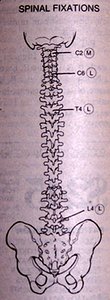Readers of this column for the last several issues are probably aware of my probing into the works of Vladimir Janda, PhD, MD, and his evaluation of the muscular system. He has made some original discoveries about the function of the muscular system and has incorporated them into a clinical approach.
To incorporate the muscle concept in my practice, I have developed the following Muscle-Spinal Evaluation Chart which works extremely well in my office as a work sheet and report of findings. This sheet does not include the orthopedic, neurological and roentgenographic findings. It is a sheet that illustrates spinal fixations, trigger points, and chronically tight muscles. The muscles are graded during the examination and the patient is made aware of the tightness present. The findings of the evaluation of movement patterns and posture are written down and also explained. The spinal fixations are circled and labeled as to the type of fixation during the motion palpation and explained. Finally, active trigger points are also written down and explained. The evaluation sheet is really two sheets, and a copy of the under sheet is handed to the patient while the doctor keeps a copy to work from. At last a patient can take home a report of findings that illustrates their structural problems and depicts exactly what the doctor is attempting to accomplish. Of course the spinal subluxation/fixation portion could also be related to the autonomic nervous system and other related areas during your report.



| Trigger Points: Infra, Rhomboid | |
| Tight Muscle: 0 to 5 | |
| 0 = Extremely Tight (No Joint Motion) | |
| 1 = Very Tight (20 Percent Motion) | |
| 2 = Moderately Tight (40 Percent Motion) | |
| 3 = Tight (60 Percent Motion) | |
| 4 = Mldly Tight (80 Percent Motion) | |
| 5 = Normal | |
| Postural Muscle Evaluation: | |
| Tight | L. Upper Trap. |
| Weak | L. & R. Serratus Ant. |
| Weak | R. Gluteus Max |
| Tight | L. Adductor |
| Tight | R. Hamstring |
| Gait: Bilateral Hyperpronation | |
| Spinal Fixation | |
| Muscular: | M |
| Ligamentous | L |
| Articular: | A |
| Movement Patterns | |
| Hip extension: | Weak R. Glut. Max, Ipsilateral Lumbar, L. Upper Trap. |
| Hip abduction: | Tight L. TFL, Tight R. Quadratus Lumboum. |
| Sit-up: | Tight Psoas, Weak Abdominals. |
| Push-up: | Weak Serratus. |
| Head flexion: | Weak Scaleni, Tight SCM. |
| Shoulder abduction: | Tight L. Upper Trap. |
| Recommendations for Minimum Care: | |
Reference:
1. Bullock-Saxton, Janda V, Bullock M: Reflex activation of gluteal muscles in walking. An approach to restoration of muscle function for patients with low back pain. Spine, 18:704-708, 1993.
Warren Hammer, MS, DC, DABCO
Norwalk, Connecticut
Editor's Note:
Dr. Hammer will conduct his next soft tissue seminar on June 26-27, 1993, in Chicago, Illinois. You may call 1-800-359-2289 to register.
Dr. Hammer's book, Functional Soft Tissue Examination and Treatment by Manual Methods: The Extremities, is now available. Please see the Preferred Reading and Viewing List on page xx, Parts #T-126 to order your copy.
Click here for previous articles by Warren Hammer, MS, DC, DABCO.





